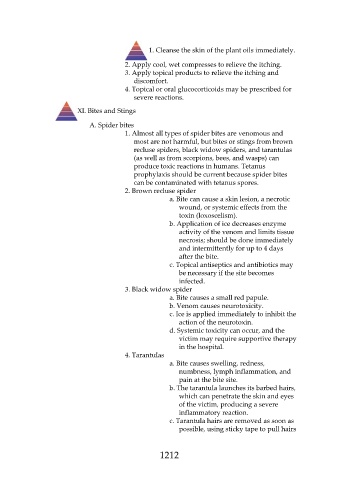Page 1212 - Saunders Comprehensive Review For NCLEX-RN
P. 1212
1. Cleanse the skin of the plant oils immediately.
2. Apply cool, wet compresses to relieve the itching.
3. Apply topical products to relieve the itching and
discomfort.
4. Topical or oral glucocorticoids may be prescribed for
severe reactions.
XI. Bites and Stings
A. Spider bites
1. Almost all types of spider bites are venomous and
most are not harmful, but bites or stings from brown
recluse spiders, black widow spiders, and tarantulas
(as well as from scorpions, bees, and wasps) can
produce toxic reactions in humans. Tetanus
prophylaxis should be current because spider bites
can be contaminated with tetanus spores.
2. Brown recluse spider
a. Bite can cause a skin lesion, a necrotic
wound, or systemic effects from the
toxin (loxoscelism).
b. Application of ice decreases enzyme
activity of the venom and limits tissue
necrosis; should be done immediately
and intermittently for up to 4 days
after the bite.
c. Topical antiseptics and antibiotics may
be necessary if the site becomes
infected.
3. Black widow spider
a. Bite causes a small red papule.
b. Venom causes neurotoxicity.
c. Ice is applied immediately to inhibit the
action of the neurotoxin.
d. Systemic toxicity can occur, and the
victim may require supportive therapy
in the hospital.
4. Tarantulas
a. Bite causes swelling, redness,
numbness, lymph inflammation, and
pain at the bite site.
b. The tarantula launches its barbed hairs,
which can penetrate the skin and eyes
of the victim, producing a severe
inflammatory reaction.
c. Tarantula hairs are removed as soon as
possible, using sticky tape to pull hairs
1212

